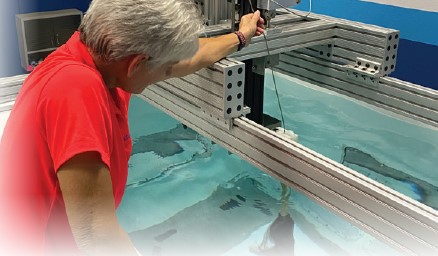membership
TACkling the Toughest Projects: PHTA's Technical Advisory Council
Diving in with the volunteers behind the scenes of America's pool codes, standards, and water quality

Behind every pool pro who is out building, selling, or servicing their customers lies a committee of 100 industry volunteers who are giving up their evenings and weekends to make these jobs profitable, safe—and even possible.
While the flashier initiatives undertaken by the Pool & Hot Tub Alliance (PHTA) promote certifications and advocate for wellness and swim education, the third leg of PHTA's mission is making waves behind the scenes to elevate consensus-based safety and industry standards. That's where the Technical Advisory Council, or TAC, comes in.
The TAC is composed of the chairs of four committees along with at-large members representing the International Hot Tub Association (IHTA), pool equipment manufacturers, and builders. Their goal? Develop, clarify, perfect, and promote standards and codes. The standards are essential to PHTA's American National Standards Institute (ANSI) accreditation; they're also a way for PHTA to help guide governmental jurisdictions, other industry groups, and consumers.
This more formalized structure creates checks and balances for standards, says Justin Wiley, PHTA's vice president of government relations, standards, and codes. The goal of the TAC is to make sure there's no room for misinterpretation.

"The work of the TAC and its committees impact the entire industry. Each subcommittee has a distinct charge and plays a critical role in PHTA's technical program," Wiley explains. "Having a PHTA Board-appointed council like the TAC coordinating the work of each subcommittee ensures that everyone is rowing in the same direction." Most of these committees are new or have been revamped in the last 4 years.
The TAC Committees
- The Standards Process Committee (SPC), a legacy group with a new structure, reviews current standards for aquatics products, develops new standards where needed, and makes recommendations to the TAC on government advocacy needs and ANSI requirements.
- The Recreational Water and Air Quality Committee (RWAQC), no longer operating alone, maintains research on chemicals, products, and processes that affect water and air quality in and around pools, hot tubs, and spas.
- The new Code Action Committee (CAC) is responsible for building code creation, advisory, and adoption alongside the International Code Council. They also keep information from the International Swimming Pool and Spa Code (ISPSC) and other external standards up to date.
- The new Editorial Review Committee (ERC) takes materials from the education department, builder's manual, technical advice, and more and ensures that the documents are aligned and comply with the current codes and standards. Their detail-oriented approach means they do everything from copyediting to checking references, adding citations, and updating links.
What's Changed

In the past, if you found documents or standards with conflicting guidance, there was no way to resolve incongruities or get clarity. In the past, if you wanted to provide input on a topic, you might not have known where to turn. PHTA heard you. Now there’s an easy way to do both. It all starts at phta.org/standards.
- Watch
Those curious about the standards development process can observe a committee meeting live or virtually. To participate, submit a short form to join those meetings that interest you. - React
Submit comments and requests for changes to codes and standards. - Advise
If you have expertise on a particular topic – even if you’re a non-member – you can participate in the process. - Volunteer
You can become a voting member of a Standard Writing Committee or the overall Standards Consensus Committee by filling out an application.
Steve Barnes has been with the Standards Process Committee for 20 years and is now the chairman.

"We can go higher now," Barnes says. "We can bring experts from outside of the industry and they can research a project. That is a massive improvement."
Making a Mark
Barnes takes his and his group's role personally. He nearly drowned as a child from a pool drain that today is considered substandard. It was the Standards Process Committee that worked to improve those drain cover standards which are now widely accepted.
"The most important achievement of my life is playing an important role in the drain cover standard," he says. "The U.S. Consumer Product Safety Commission stated that it's the only law that they know of for a product standard that, when followed, has been 100% effective."
TAC committees have also:
- Unified energy efficiency standards across state lines, saving consumers and the industry hundreds of millions of dollars
- Created and promoted adoption of unified ISPSC and PHTA standards to help multi-state builders
- Worked with manufacturers on guidelines that allow them to streamline design and production to serve the entire U.S.

Wendy Purser, chair of the CAC and a representative on the ISPSC's development committee, says that she's proud to be a member, and "the new process that has been put into place is working well."
A Sense of Purpose
Dedicating 5-10 hours per week over many years has been easy for Barnes, whose work as director of science and compliance at AquaStar is closely aligned. He stays motivated by his mission to maintain PHTA's ANSI accredited standards for safety and reliability. He also wants to ensure that education on the standards is both effective and measurable. His goal is to "take what we know to be important and simplify it down to a checklist."
Same for Purser, who works as a pool consultant and inspector. More universally recognized code implementations are crucial in sending a message to consumers, building officials, and designers that all industry standards and codes have been considered and implemented into the ISPSC.
Once Barnes' and Purser's committees complete their work, the ERC reviews PHTA's educational offerings to ensure they're consistent with industry standards, codes, and best practices.
"Now they can have a high degree of confidence in us as a group," Barnes says.
Shaping the Future
The future is starting now for the codes and standards of the aquatics industry. PHTA is leaning into the expertise, skills, and commitment of its members. For the CAC, this mission is focused on completing the ISPSC development process, the next edition of which is set to be published in 2027. Progress for these codes is well underway on topics, Purser notes, including:

- Number of bathroom facilities at public pools
- ADA and fire code requirements
- Testing methods for pool color surface reflectance
- Construction materials and protection of footings
Members interested in getting a look at PHTA's ISPSC change proposals should visit phta.org/codes. Anyone can participate in ICC's upcoming Committee Action Hearings in Long Beach, CA, which take place October 23-31, 2024. From here, final decisions will be made using ICC's Governmental Consensus Process. It's just one more duty that PHTA is up to tackle, thanks to the contribution of time and expertise by its volunteers.
"This is an orchestra, and the TAC is the conductor," Wiley says. "It all comes together as a symphony for our PHTA members."








